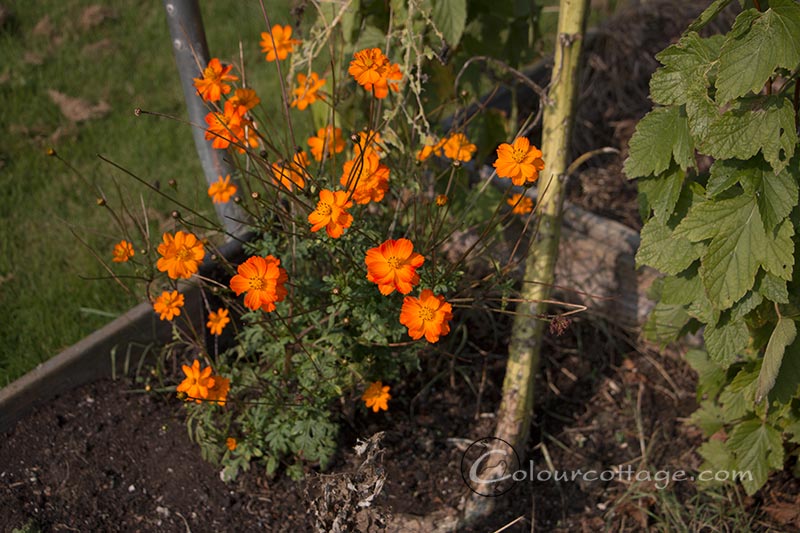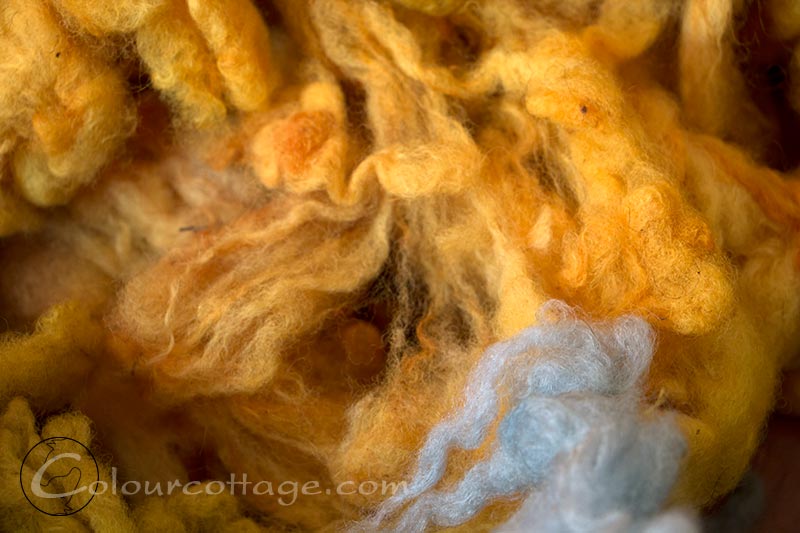 Last year weeds happened to my orange cosmos (it always starts growing very late for some reason – then blooms into October where it’s too wet to collect seeds properly), this year slugs have overrun our entire property, so I had one plant. For that reason I had a handful of flowers in the freezer from last year and collected all summer from my one little very brave specimen to get enough for a reasonable amount of wool. Continue reading “Frozen flower dye”
Last year weeds happened to my orange cosmos (it always starts growing very late for some reason – then blooms into October where it’s too wet to collect seeds properly), this year slugs have overrun our entire property, so I had one plant. For that reason I had a handful of flowers in the freezer from last year and collected all summer from my one little very brave specimen to get enough for a reasonable amount of wool. Continue reading “Frozen flower dye”
Tag: natural dyeing
The yarn that wouldn’t
As I mentioned in passing yesterday, I had some non-results with dried walnut on one of my overdye projects. I can’t remember what came first, I think possibly alum and St. John’s Wort solar dye method (= mucky fawn).
Then I tried dried walnut shells, bought in a store, not collected, regrettably. (=beige) Ammonia: no change. Yes, it really lost colour compared to the original.
Another option would be mixing my used dye jars of hollyhock, cochineal and safflower on the odd chance they were not exhausted from the other hanks I showed yesterday. (=this added a slight greyish tint to the beige)
Dumping the science projects
For a while I’ve been recording facts about each yarn I’ve plant dyed, I’ve made solar and indirect light exposure tests (more about that when I have the energy to make a list), the pH values, the modifiers.
Well, I felt it was time to lose that for a while.
Late dye harvest
Eager to try drum carding my Dorset fleeces (with a bit of Suffolk mixed in, they had not been separated) I decided last weekend to make a final raid on the dye garden to make it more fun than just white (I do still have a bag of white from last year of what I think is Suffolk). I know I said I was done, but I got two more fleeces, didn’t I. Same sheep – this time I only kept the best bit, perhaps a third of what I was given rather than 2 thirds. I haven’t weighed it though.
And it turned out both the weld and the woad were still fine to use, green and fresh. I had dried some bundles of tansy hanging them from the stable ceiling – and left them there, so they are now covered in “dust” – mold spores. I decided to boil one bundle anyway and put some fleece in. Giving out colour just fine, but I’m chucking the other three bundles.
The last batch went in with some onion skins that were sitting on the kitchen counter anyway and a few cochineal sprinkles on one side, which oddly enough didn’t do much besides turn the water red.
I used rather a lot of fleece in the woad vat, so apart from the green that didn’t turn out too interesting. But I can always dye the yarn again, or, if we don’t have any frost, go look for more plants in a few weeks.
Earlier this year I handcarded the part of the fleeces that I had acid dyed, and it took me FOREVER. My test bat on the drum carder last week took no time at all, no effort, no tired hands – so I’m very optimistic I can get spinnable fiber relatively easy. I’ll first card each shade on its own to straighten it out a bit, then I may blend.
Sen farvehøst
Jeg har jo længe gerne ville karte alle mine gratishamme, som jeg har plantefarvet gennem de sidste par år i bundter, både fordi de fylder ret meget og fordi det er en stor opgave når de er så fyldt med fnidder og knuder. Og så sagde jeg ja til to hamme mere i år, dog blev de sorteret med ret kræsen hånd.
Det sidste uld ville jeg ogsÃ¥ lige have farvet, sÃ¥ det er lidt sjovere at arbejde med, sÃ¥ en tur i haven og hente bÃ¥de vaid og vau, som stÃ¥r fine, friske og grønne endnu. Jeg havde hængt bundter af rejnfan under staldloftet til tørring – og derefter ladet dem hænge sÃ¥ de nu i det fugtige vejr er blevet helt dækket af et fint lag støv, eller rettere mugsporer. Jeg proppede det ende bundt i en gryde, og det farver fint, men de andre ryger ud. Og en bunke uld røg i en gryde med gÃ¥rsdagens løgskaller.
Jeg fik proppet lige lidt rigeligt i gryden med vaid, sÃ¥ bortset fra de grønne nuancer blev det lidt kedeligt – men enten kan jeg jo overfarve garnet eller ogsÃ¥ venter jeg med at karte den bunke og ser om det evt. holder frostfrit en mÃ¥neds tid endnu og mÃ¥ske jeg kan finde flere planter? Ellers har jeg faktisk en spandfuld blÃ¥ farve stÃ¥ende fra sidst.
Tidligere på året håndkartede jeg jo den del af hammene som jeg havde pulverfarvet, og det tog en evighed. Men det testbat jeg kartede på maskine sidste uge gik som en leg, så håber på jeg kan få de her kødfår i hæderlig stand rimelig nemt og hurtigt. Jeg tror jeg først karter hver nuance for sig og så kan jeg blande i anden omgang.
Purple or blue?
I needed a bit of blue to conclude my goldenrod chapter as well as testing if Dylon Color Run Remover works the same as our local brand which was more expensive.
My Japanese indigo is still growing new leaves and left me with a harvest of 90 g leaves to 40 g of yarn including half the rose coloured cochineal hank from Friday and samples from the other two, so I thought I was good to go. Only I must have heated it too long or something, because I could not change the colour of the dyebath after adding soda, so I didn’t bother trying to reduce it.
So I went and looked at my overgrown ex vegetable garden and luckily the woad is still growing abundantly too. I think I’ll stick with it, much lower maintenance as it takes care of itself in our climate, and much easier to extract.
And this is what I got from one 30 min. dip.
Rosafarvet cochenille overfarvet med vaid.
Meningen var egentlig at bruge japansk indigo, men jeg kunne ikke få badet til at skifte farve. Da den samtidig er sværere at dyrke, og vaid bare passer sig selv på en brakmark i vores klima, så tror jeg bare jeg holder mig til sidstnævnte i fremtiden, den har været nem at følge proceduren med hver gang.




